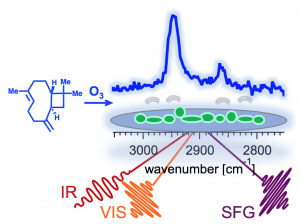We are happy to report that our first paper in ACS Earth & Space Chemistry is now published. In this work, we integrated organic synthesis, secondary organic aerosol synthesis and collection, DFT calculations, and vibrational sum frequency generation spectroscopy and identified close spectral matches between the surface vibrational spectra of β-caryophyllene-derived secondary organic material and those of beta-caryophyllene aldehyde and β-caryophyllonic acid at various interfaces.
Combined with the record high surface tension depression described previously for these same oxidation products, we discuss possibilities for an intrinsically chemical origin for cloud activation by terpene-derived surfactants. Although the present study does not unequivocally identify the synthesized and analyzed oxidation products on the β-caryophyllene-derived SOM surfaces, these two compounds appear to be the most surface active out of the series, and have also been foci of previous β-caryophyllene field and laboratory studies. An orientation analysis by phase-resolved SFG spectroscopy reveals a “pincer-like” configuration ofthe β-caryophyllene oxidation products, albeit on a model quartz surface, that somewhat resembles the orientation of inverse double-tailed surfactants at the surfaces biological systems.
The structural information suggests that the less polar moiety of a surface-localized oxidation product, such as those studied here, may be the first site-of-contact for a gas-phase molecule approaching an SOA particle containing surface-active β-caryophyllene oxidation products.
